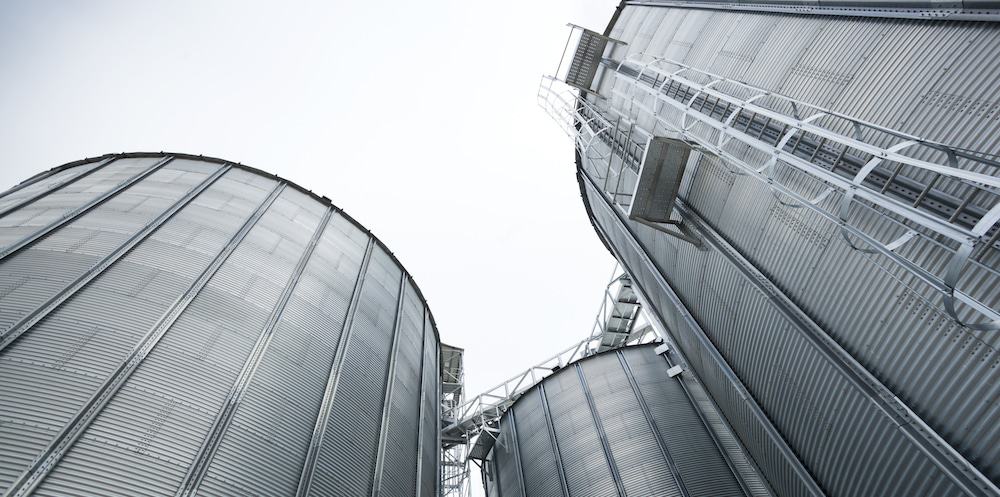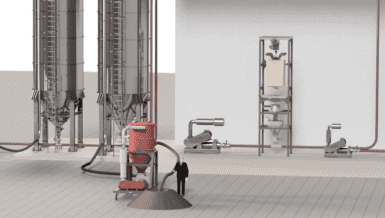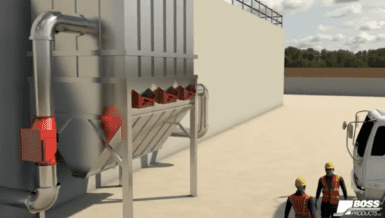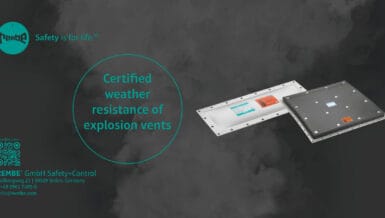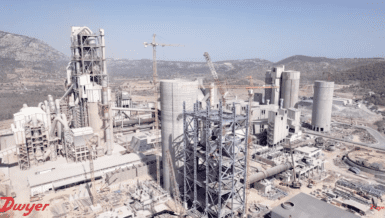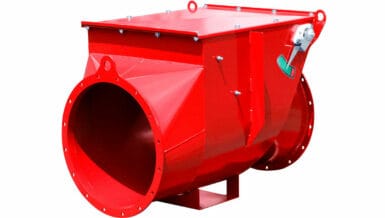In a wide variety of industrial applications the dust generated by the combustible bulk solids or the solids themselves can be explosive when suspended in air. Explosive dust-air clouds are typically generated during the filling and emptying process of silos creating a sufficient concentration of airborne product to sustain a dust explosion.
When a dust deflagration takes place in a confined volume, the explosion quickly increases and when the design strength of the silo is exceeded, structural damage occurs releasing the hazardous pressure and flame into the surrounding atmosphere. The weakest areas of the silo, often the silo roof, access doors and connected piping, are the first to fail and can become projectiles causing significant damage. Unburnt material will be blown into the surrounding atmosphere and will create a dangerous fireball which can be up to 75 times the volume of the silo itself. Silos are in many case connected to other systems through piping, ductwork and conveyors through which the explosion can propagate causing secondary explosions throughout the production plant.
Preventive measures can be taken to stop potential ignition sources such as electrostatic discharge and sparks from entering through the silo inlet or prevent nests of smoldering material inside the bulk solid. Airborne dust-air clouds can be reduced through dust extraction systems or even removing oxygen from the inside of the silo through the injection of an inert gas. Although these precautions will reduce the risk a dust deflagration taking place they are not failsafe and constructive dust explosion protection systems are needed to mitigate the potential catastrophic consequences of a dust explosion.
With new silo constructions, the silo manufacturer or plant constructer most often implements the explosion safety measures however, for many systems new or old, which need to be upgraded over time, the owner or plant operator will have to implement the necessary measures. Suitable protection can either be achieved with an active explosion protection system (a system that uses sensors to detect an explosion in its incipient stages and activates explosion suppression and isolation devices) or by a passive explosion protection system (which uses the energy release of the explosion to mitigate its hazardous consequences). While passive solutions are most cost effective to install and maintain, active solutions may provide more flexibility in implementation especially on smaller silo types such as day bins or bulk storage silo’s located inside production facilities.
Within passive explosion protection the explosion itself is not halted but instead the pressure and flame is released out of the silo ensuring that the internal pressure remains below the design strength of the silo itself. This is achieved through the use of explosion vent panels. The vent panel will open at a predetermined set pressure and provide a planned pathway for the expanding gases, which are the reason for the pressure rise, to escape. The quantity and size of the vent panels is determined by the volume and shape of the silo, the installation location and efficiency of the venting panels, the dust explosion characteristics of the material stored within the silo and the design strength of the silo.
Ideally vent panels are placed on the roof of the silo as this does not affect its maximum fill level and the resulting reaction forces being generated during the explosion venting process cannot cause a silo to collapse (although structural integrity needs to be verified based on the calculated reaction forces for each installation). The flow created by the explosion event will cause unburnt material to escape and continuie to burn outside of the silo. To prevent this flameball from causing damage or posing a danger to factory personnel or other people it is important that it is vented to a safe locations. As this is impractical inside buildings and factory halls, flameless venting devices can be installed on top of the vent panel. These devices typically use various layers of steel mesh material that absorb the heat produced during a combustion thus quenching the flame and only releasing the pressure into the surrounding area. As flameless venting devices typically require more venting area than explosion vent panels alone these are not practical on larger silos. Passive explosion isolation valves such as flap valves or poppet valves are not ideally suited for the use on silos due to limited airflows, high product concentrations and sizes of the interconnected piping. Therefore active isolation valves such as pinch valves or fast acting slide valves are more commonly utilized.

In installations where venting or flameless venting may not be possible due to the installation considerations or working with harmfull or volatile chemicals, etc. an active explosion protection system can be used. Explosion pressure detectors and/or optical flame are used to detect an explosion in its early stages. Within milliseconds, the control systems send an activation signal to suppressant containers, mounted on the silo, to activate and inject suppressant powder inside, quenching the explosion before the pressure inside the enclosure reaches the design strength. Explosion isolation can be achieved through mechanical slide valves or chemical isolation where the same suppressant powder is used to stop flame propagation through pipes and ductwork. When mounting chemical isolation systems on mechanical conveyance systems, (often used for silo filling), care need to be taken to place the chemical isolation system so that the suppressant powder fills the entire conveyor volume, something which is not always a simple task due to the internal obstructions, to effectively isolation the explosion.
In its search for a suitable explosion protection system provider the silo manufacturer or plant owner needs a trusted partner with knowledge, expertise and a broad product range to provide the best possible explosion protection solution that fits the application and business needs to the user. A prime example of the necessity of such a partnership between customer and explosion protection provider is the partnership between Fike and a globally renowned EPC (engineering, procurement, contracting firm) hired to design and manufacture an array of silos for a large biomass energy plant. The silos were to be constructed out of reinforced concreter with a height of more than 50 meter and a diameter of over 35 meter. The roof, which was manufactured from steel, was to contain the required explosion vent panels.
All silos were designed to be filled with a common conveyor discharging into a spiral chute ensuring the filling process was uniform and with a minimum amount of dust generated. No experimental explosion venting data exists that is representative for the large volume of the silos in question which also exceeds the limits as to which the EN and NFPA standards give guidance. Additionally traditional vent sizing methods assume conservatively optimal and homogenous dust concentrations over the entire internal silo volume. In order to deal with these facts, instead of using volume extrapolations of standardized eexplosion vent sizing methods which leads to a large required venting area exceeding the available area for the installation of explosion vent panels, Fike carried out computer simulation using computational fluid dynamics software (CFD) to enable the determination of the appropriate vent area for this specific application of wood pellet storage. The results allowed the customer to not only drastically reduce the amount of required vent panels but also understand the external effects of the dust explosion including the size of the flameball outside of the silo and reaction forces on the silo itself.



